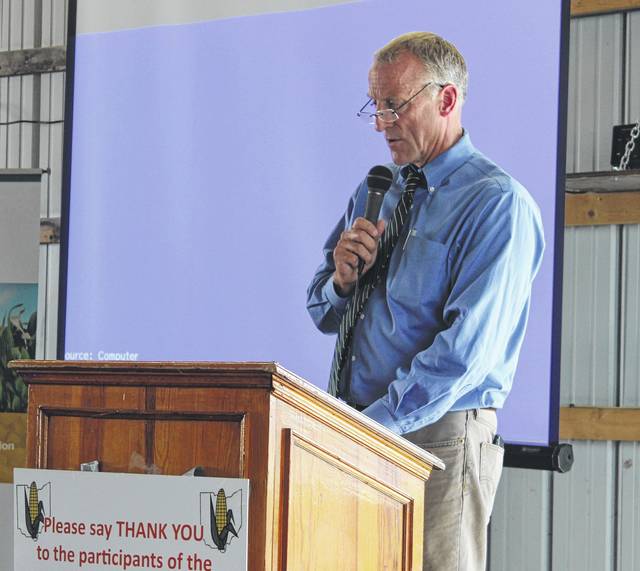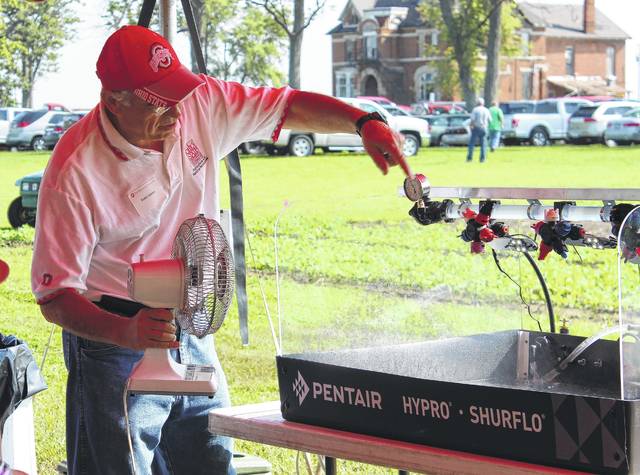

The Southwest Ohio Corn Growers Association (SWOCG) held its annual Agronomy Field Day Tuesday at the Fayette County Airport. The event, which was done in conjunction with the Fayette County Ag Committee, was a day-long collection of shows featuring educational sessions on various topics, a lunch provided by the SWOCG and Fayette County Ag Club and the afternoon was capped off with a lunch, keynote speaker, and panel discussions.
This year’s keynote speaker was originally slated to be Sonny Perdue, the U.S. Secretary of Agriculture, but he was unable to attend. Brian Klippenstein, Perdue’s Senior Policy Aid, was sent in his place and spoke after lunch. Klippenstein is a former Senate Board member from Missouri and comes from a farm background. His message to the farmers of Ohio was one of reassurance, telling them that Perdue and the Ag Department will work for them.
“[Perdue] is an accountability guy, a customer service guy,” Klippenstein said. “He considers food a national security issue.”
Much of Klippenstein’s speech (and the topic overall) was to do with the future of agriculture, both in the short term with regard to the next Farm Bill, and in the next 30 years of farming in the country.
“I had someone use this statistic and I asked some other economists to verify it and they said it was true,” said Klippenstein. “You all have to grow the same amount of food in the next 35 years as we’ve produced in the previous 7,000.”
His focus was the time between now and 2050 and what both farmers and the federal government has to do to make that successful and sustainable.
That future of farming, particularly in Ohio, was also discussed in the education sessions that were given throughout the morning. Speeches were given by a variety of professors and researchers from The Ohio State University on topics which directly impact the day-to-day workings of Ohio farmers.
Among the speakers were Dr. Erdal Ozkan, an engineer at OSU, who gave a talk about the complications on spray drift with regard to pesticides and what nozzles farmers could choose to better control their spraying. Dr. Pierce Paul at OSU talked about corn diseases and diagnostics. John Fulton of OSU discussed the possibility of higher speed planting and Elizabeth Hawkins of OSU talked about the use of Nitrate during the planting and growing seasons.
The talks acted as a foundation for the topics which would be brought up in the afternoon panel with the keynote speaker and others.
Klippenstein joined Brooke Appleton, the National Corn Growers Director of Public Policy, Jonathon McCraken, Ag Aid to U.S. Sen. Sherrod Brown and Fred Yoder, U.S. Ag Advisory Committee for President Trump for the panel discussion, which was led by Dale Minyo of Ohio Ag Net.
The discussion focused primarily on the Farm Bill: what will be in it and how Ohio farmers might be affected. Additionally, there were a couple questions with regard to conservation, a topic discussed in one of the education sessions earlier in the day. Conservation of land has been brought up in the Ag world as both a way to protect land but also as a way for farmers to set aside parts of their property that may not have high yields. But with budgets being tight, the question of where all the money will come from has come up time and again.
“I don’t see threats to conservation, it’s another non-partisan objective,” Klippenstein said. “The reason that the public and the taxpayers share in the cost of taking care of the land is because this private property has been considered part of the public’s concern. So if the public cares enough about the conservation of all this land, they should share in its protection.”
The thought was echoed by Brooke Appleton during the discussion.
“It is important for all sides,” she said. “Can improvements be made to CSP (Conservation Stewardship Program)? Absolutely. But you don’t hear as much about it because it’s not as contended by both sides.”
Another highly discussed topic was that of American exports. Jonathan McCraken summed up the panel’s consensus in his response.
“We grow it here. Well, let’s make it here,” he said.” I think it’s in all our best interests to have a real soup-to-nuts approach to this, when it comes to the grow-it-here, make-it-here initiative.”
He emphasized the importance of using the resources grown in abundance in places like Fayette, Madison and Union counties. Fred Yoder expanded on the notion by highlighting the effectiveness of American Ag.
“We are constantly working on that,” Yoder said. “Like I said earlier, we can produce like no one else in the world.”
.neFileBlock {
margin-bottom: 20px;
}
.neFileBlock p {
margin: 0px 0px 0px 0px;
}
.neFileBlock .neFile {
border-bottom: 1px dotted #aaa;
padding-bottom: 5px;
padding-top: 10px;
}
.neFileBlock .neCaption {
font-size: 85%;
}



